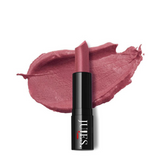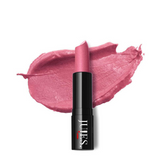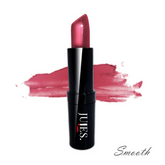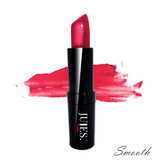Which Mistakes Do You Make When Covering Your Breakouts?
Breakouts are a nightmare and covering them up can be too.
When I get asked about how to cover breakouts, I have found that people in general make these 7 common mistakes.
The first two have to do with improper preparation of skin prior to applying cosmetics and the remaining mistakes pertain to decisions of product type, color, and application methods.
You may not be committing all of these crimes but any one of these will complicate your ability to hide your breakout with all-day coverage all while avoiding an artificial and/or cakey end-result.
I will have each makeup offense listed in order of your application process.
Mistake #1: Picking. Popping. Poking. Prodding.

KNOCK IT OFF.
Covering a big red bump is one thing but covering an open wound is next to impossible.
I know it's tempting, but please don't pick at your breakouts, especially when they aren't ready. You will only cause scarring and possibly a nice scab that will stay there 3x as long as the breakout would have on it's own.
Not a good plan of action.
Mistake #2: Flaking is not okay.
The next most common error is trying to put makeup on top of your over-treated skin.
Between cleansing with benzol peroxide or salicylic acid and then using your perscription spot treatment--you're skin is likely to be a flaky mess.
This is no good either.

Dry, flaky skin will never look better with foundation.
Spend all the money you want on it and I can guarantee you will come out looking like you put on a paper mâché mask and never like a beautiful porcelain doll. It just isn't going to happen.
So how do you fix it?
If you're struggling with dry patches because of a prescription acne treatment, I recommend adding a gentle scrub to your routine a couple times a week to help lift off the remaining dead cells, leaving you with a softer, fresher complexion as a base to apply your foundation.
The gentle scrub I typically recommend is this Exfoliating Enzyme Scrub. It has soothing ingredients to calm inflammation while the enzymes nibble away at the dead cell and the scrub portion gently sloughs away at the flaky build up.
Don't get ahead of yourself now, you're not done prepping yet.

Moisturizer is important even if you have breakouts.
Dehydrated, over-stripped skin will only exacerbate your skin issues while simultaneously increasing the speed of pre-mature aging and leaving your skin looking haggard. Makeup is not the answer to this problem.
Moisturizing Problematic Skin:
- Oily and broken out? My recommendation is Phytomer's Hydra Original Non-Oily Mosturizing Fluid. This serum will help replenish your dehydrated skin without clogging you from oily emollients found in most moisturizers.
- Dry and zitty? I generally recommend Phytomer's Accept High Tolerance Neutralizing Cream as your moisturizer.
In this circumstance, it is almost always the case that your breakouts are being caused by some sort of reactivity, be it stress, hormones, food, etc. The neutralizing ingredients in this lightweight, Neutralizing Moisturizer will help calm the skin so it can better heal itself from these other stressors whether they are environmental, internal, or both.
Now that your skin is properly prepped, what else have you been doing wrong?

Mistake #3: Applying thick makeup EVERYWHERE.
This is one of the biggest mistakes I find. Everyone wants full coverage foundation and you're usually applying this already heavy makeup with a brush or sponge.
First-off, put the applicators down. These tools will only cause you to lay down too much product and clog your pores more.
When you apply too much makeup you can cause additional clogging all while wasting your hard-earned money. This is not to mention the fact that this thick layer you've just applied will start to breakdown and move throughout the day.
Not cute.
Most people don't wash brushes enough or change sponges as frequently as they should. Clean fingertips will actually allow you better control and waste less product. The heat of your fingertips will help gently blend the foundation into place as you apply this in a down and out motion with gentle fingertips.
Don't smack on your foundation, or rub heavy-handed.
Furthermore, I want to make this very clear: Do not cover your whole face just because of a few problem areas. Only put the coverage where you need it most.
Putting thick makeup over your whole face is unnecessary and looks ridiculous.

Use a build-able coverage foundation instead. This will keep you from overdoing the areas of your face that don't need it, while giving you control to apply a little more where you need it most.
What foundation should I look for?
My favorite foundation to use for textured, acneic skin (usually oily or combination) is Stick Foundation. I have found in my career that this type of foundation sits well on textured skin without drawing unwanted attention to flaws.
Stick foundations are build-able, cream to powder formulations. This technology keeps the foundation from breaking down halfway through the day and holds well on top of breakouts.
Many liquid foundations sit well everywhere except where you want it most: the breakout. This is not a problem you are likely to find with this versatile product.
For dry, broken out skin (oil build up is not an issue)-- I LOVE this Luminous Foundation.
This formulation gives the perfect coverage. The light, almost mousse-like consistency, glides on and diffuses imperfections. It gives your stressed out skin a nice fresh finish you want without the cake-face you're trying to avoid.
Mistake #4: Wherefore Art Thou Concealer?

So many people when making mistake #2, are trying to use their foundation the way you should be using your concealer.
Now that you have a delicate approach to your overall complexion. You can now use your concealer for the few remaining eye-sores.
Always do large areas first (foundation) and small areas second (concealer).
It is so important that when you conceal a blemish you gently pat and press the product onto the spot and be sure you don't over-blend.
Rubbing is a big NO-NO. Unless you're trying to waste product, further irritate your already sensitive skin, and get nowhere...I suggest you stop doing this to yourself.
Mistake #5: Your concealer shade is all wrong.
Color is critical when it comes to concealing breakouts.
If you use the wrong color, you can draw unwanted attention to the area and dull your complexion on top of it.
Remember art class? Light colors draw things into the foreground and darker makes things recede to the background. If you use a color that is too light, you might bring more attention to it by mistake.
Perhaps it will no longer be a visible red bump, but if you're using something far too light, I can guarantee that it will remain a beige bump that introduces itself before you do...and that's just rude.
To avoid this mistake,
When you are dealing with the remains of a breakout in the form of hyper pigmentation and scarring (these are usually darker and more purple-red or if scarred, purple-grey), it is best to use a concealer with a peach-tone to keep the spot from looking ashy when covered.

You want to keep it in the same color level as your foundation, just simply a hue peachier.
If you are dealing with small regular bumps that aren't as challenging or pigmented, you can keep the concealer approximately the same as your foundation shade without a worry--just don't get carried away with something lighter than your complexion.
What type of concealer is best?
For covering a few individual larger more challenging pimples--I recommend using the Liquid Concealer.

This product is SUPER concentrated and one drop will give you all day coverage.
I would restrict using this for under-eye and/or specific pimples--but don't apply this on a larger section, it will be more than you need.
If you are zone-concealing smaller, annoying bumps:

I prefer to use the Dual Action Concealer.
This product works miracles on patchy areas and makes texture disappear on problematic skin. It gives you the extra coverage you want without risk of over-doing it.
Mistake #5: Neglecting Powder
This one is short and easy: If you aren't using it...get it.
Neglecting powder is silly. You absolutely need powder on top of your cream/liquid products to keep them from breaking down or rubbing off before the end of the day.
Not sure what powder to use?

When choosing powder: Mineral is King.
Many powders, especially setting powders today are still talc-based. Talc is hands-down a better oil-absorber, but it comes with sacrifices.
Talc is not as healthy for your skin as mineral and will also sit on top of your skin, appearing thicker, dryer, and more artificial, whereas mineral powder diffuses onto the skin for a natural finish.
Now that you've got the right powder...let's talk about application.

Mistake #6: Swirling when applying powder.
When applying powders people commonly use two approaches, brush or sponge.
If using a brush, people often use a big, fluffy brush and use swirly motions to apply. This is a huge NO, especially when you are covering breakouts.
If you swirl your powder on when applying, congratulations, you have just broken down everything you just worked so hard to cover.
You instead want to use a slightly smaller, flatter brush and while using the flat of the brush you want to pat (stipple) your powder on instead of swirling. This will ensure you have set your makeup without uncovering your pesky pimples in the process.
A sponge-application will lay down a thicker layer of powder. This is okay, but I recommend using a fresh sponge every application to prevent oil-transfer or bacterial buildup.
If you have a particularly oily complexion, it is my preference to use a cotton round and pat your powder with a fresh round instead of a sponge. The cotton does a better job absorbing excess oil while simultaneously depositing fresh powder.
Mistake #7: Getting your glow on.

Highlighter is the enemy when you are dealing with textured, broken-out skin.
Maybe you like the way highlighter can photograph given the right angle, lighting, filter, and proper editing. But let's not forget that you live in the real world and if you want the honest truth: In natural light to the naked eye--you will look like you've made a huge mistake.
Highlighter is not your friend. The light-reflecting particles will pick up and enhance every bump and blemish on your complexion.
Pearl is found in highlighters and is also hidden in many blushes, bronzers, and powders as well.
Be diligent when choosing these products and at all costs, AVOID SHIMMER! You may think you love it, but I assure you, your skin does not.
When the time comes that you have your breakouts under control--feel free to go crazy and glow all over, but for now--matte is the best path to flawless.

In a nutshell,
1. Stop picking.
2. Prep properly.
3. Apply full coverage only where it is necessary.
4. Concealer is the real savior.
5. Color is key.
6. Power is in the powder.
7. Application methods will make or break you.
8. Forego highlighter and embrace matte perfection.
I hope these mistakes have been enlightening and will help you achieve the flawless finish you have been looking for! And when all is said and done, I want to remind you all that you are your worst critic.
Be sure to give yourself a break when judging your appearance. You are even more beautiful than you probably realize.



